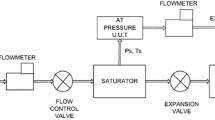Abstract
During calibration of precision optical dew-point hygrometers (DPHs), it is usually necessary to take into account the pressure drop induced by the gas flow between the “point of reference” and the “point of use” (mirror or measuring head of the DPH) either as a correction of the reference dew-point temperature or as part of the uncertainty estimation. At dew-point temperatures in the range of ambient temperature and below, it is sufficient to determine the pressure drop for the required gas flow, and to keep the volumetric flow constant during the measurements. In this case, it is feasible to keep the dry-gas flow into the dew-point generator constant or to measure the flow downstream the DPH at ambient temperature. In normal operation, at least one DPH in addition to the monitoring DPH are used, and this operation has to be applied to each instrument. The situation is different at high dew-point temperatures up to 95 °C, the currently achievable upper limit reported in this paper. With increasing dew-point temperatures, the reference gas contains increasing amounts of water vapour and a constant dry-gas flow will lead to a significant enhanced volume flow at the conditions at the point of use, and therefore, to a significantly varying pressure drop depending on the applied dew-point temperature. At dew-point temperatures above ambient temperature, it is also necessary to heat the reference gas and the mirror head of the DPH sufficiently to avoid condensation which will additionally increase the volume flow and the pressure drop. In this paper, a method is provided to calculate the dry-gas flow rate needed to maintain a known wet-gas flow rate through a chilled mirror for a range of temperature and pressures.
Similar content being viewed by others
Abbreviations
- d a :
-
Density of dry-air component of humid air
- \({e_{\rm w} \left(t \right)}\) :
-
Saturation vapour pressure above water at temperature t in pure phase
- \({e_{\rm w}^{\prime} \left({p,t} \right)}\) :
-
Saturation vapour pressure of a mixture of vapour and CO2 free air and N2 respectively
- \({f_{\rm w}\left({p,t}\right)}\) :
-
Enhancement factor
- M a :
-
Molar mass of dry air
- n :
-
Total numbers of moles at output SHG
- n′:
-
Total numbers of moles at output condensation trap
- n a :
-
Numbers of moles of dry air
- n v :
-
Numbers of moles of vapour at output SHG
- \({n_{\rm v}^{\prime}}\) :
-
Numbers of moles of vapour at the output of the condensation trap
- p :
-
Pressure
- p a :
-
Ambient pressure
- p h :
-
Pressure at the point of use (i.e., at the chilled-mirror sensor)
- p ref :
-
Gas pressure at point of reference
- q :
-
Humid-gas volume flow at the point of use (mirror head)
- q m.a :
-
Dry-gas mass flow at the DPH-branch (connection lines, point of use condensation trap)
- q in :
-
Dry-gas volume flow into the generator
- q m.in :
-
Dry-gas mass flow into the generator
- q out :
-
Volume flow coming out of the condensation trap
- R :
-
Universal gas constant
- T :
-
Absolute temperature
- T 0 :
-
Absolute temperature at 0 °C
- t a :
-
Ambient temperature
- t d :
-
Dew-point temperature at point of reference
- t d.h :
-
Dew-point temperature at point of use
- t h :
-
Gas temperature at point of use
- t v :
-
Temperature of connection line to the generator
- V :
-
Volume
- x v :
-
Water-vapour mole fraction generated with SHG
- \({x_{\rm v}^{\prime}}\) :
-
Water-vapour mole fraction after condensation trap
- \({\Delta p}\) :
-
Pressure drop between point of use and point of reference
- \({\Delta t_{\rm d}}\) :
-
Pressure-drop effect on dew-point temperature
References
L.P. Harrison, in Humidity and Moisture Fundamentals and Standards, vol. 3, ed. by A. Wexler, W.A. Wildhack (Reinhold Publishing, New York, 1965), pp. 3–69
Sonntag D.: Z. Meteorol. 70, 340 (1990)
Greenspan L.: J. Res. Nat. Bur. Stand. (U.S.) Phys. Chem. 80A, 41 (1976)
B. Hardy, ITS-90 formulations for vapour pressure, frostpoint temperature, dewpoint temperature and enhancement factors in the range −100 to 100 °C, in Proceedings of Third International Symposium on Humidity and Moisture (National Physical Laboratory, London, 1998), pp. 214–221
P717 EURAMET Comparison in humidity (dew-point temperature high range), http://www.euramet.org/index.php?id=tc-t-projects&no_cache=1&ctcp_projects[cmd]=details&ctcp_projects[uid]=596
H. Mitter, The BEV/E+E Elektronik standard humidity generator, in Proceedings of 5th International Symposium on Humidity and Moisture, Brazil, 2006
P. Mackrodt, R. Benyon, G. Scholz, State-of-the-art calibration of high-range chilled-mirror hygrometers and their use in the intercomparison of humidity standard generators, in Proceedings of Third International Symposium on Humidity and Moisture (National Physical Laboratory, London, 1998), pp. 159–166
Benyon R., Mitter H.: Int. J. Thermophys. 29, 1623 (2008)
Author information
Authors and Affiliations
Corresponding author
Rights and permissions
About this article
Cite this article
Mitter, H., Böse, N., Benyon, R. et al. Pressure-Drop Considerations in the Characterization of Dew-Point Transfer Standards at High Temperatures. Int J Thermophys 33, 1726–1740 (2012). https://doi.org/10.1007/s10765-012-1345-3
Received:
Accepted:
Published:
Issue Date:
DOI: https://doi.org/10.1007/s10765-012-1345-3




